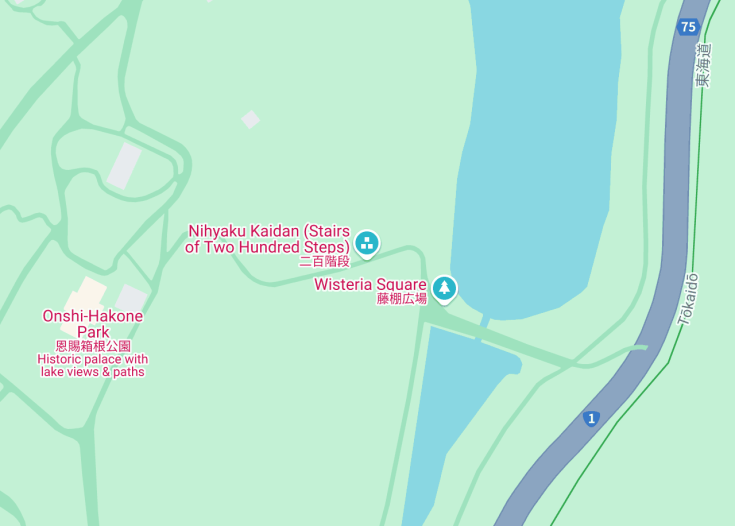Nestled in the quaint town of Matsue in Shimane Prefecture, the Nihyaku Kaidan, or Stairs of Two Hundred Steps, ascend to the historic Shiomi Nawate Street. This site not only offers a physical challenge but also a spiritual journey, as it is closely associated with the local Matsue Shrine. Visitors are treated to a panoramic view of Lake Shinji at the summit, making the climb a rewarding experience. This journey is perfect for history enthusiasts and nature lovers alike.
Wear comfortable shoes and stay hydrated, as the climb can be quite strenuous, especially during the warmer months.
Time your visit to catch the sunset over Lake Shinji from the top of the stairs, offering a breathtaking view and a perfect photo opportunity.
Nihyaku Kaidan (Stairs of Two Hundred Steps): A pathway to serenity and views
The Nihyaku Kaidan, or the Stairs of Two Hundred Steps, is a prominent feature in Hakone, Japan, offering visitors a unique combination of physical challenge and scenic beauty. Situated near the ancient Hakone Shrine, these steps wind through lush forests, leading to breathtaking views of Lake Ashi and the surrounding Hakone mountains. This stairway is not just a pathway, but a journey through the natural and cultural heritage of the area, making it a favorite among tourists and locals alike.
Climbing the Nihyaku Kaidan is considered a spiritual experience by many, as it culminates at the shrine, a site revered for its historical and mystic significance. The journey and the views it offers encapsulate the serene beauty of Hakone, making it a must-visit for those seeking peace and natural beauty. Along the way, markers and statues enrich the route, providing insight into the local lore and history, enhancing the experience beyond just a physical exercise.
Explore and unwind: The rewards at the summit
Reaching the top of Nihyaku Kaidan does more than just offer a sense of accomplishment. At the summit, hikers are rewarded with stunning panoramic views of Lake Ashi, often enveloped in mist, creating a surreal landscape. This spot is ideal for photography enthusiasts and nature lovers who wish to capture the essence of Hakone’s natural beauty. Additionally, the area at the top around the shrine is perfect for quiet reflection or meditation, away from the hustle of city life.
Seasonal changes bring a different character to the landscapes, with cherry blossoms in spring and vibrant red leaves in autumn, making every visit unique. For those interested, guided tours are available, providing deeper insights into the history and significance of the stairs and the shrine.
A relic of history: The ancient cedar trees
One of the most enchanting features of the Nihyaku Kaidan is the ancient cedar trees that line the path. These towering trees are believed to be over several hundred years old and add a timeless, mystical quality to the ascent. Their impressive height and thick branches offer shade and respite for climbers on sunny days, making the journey more pleasant.
These cedars are not only a beautiful natural spectacle but also serve as spiritual guardians in local beliefs, said to protect the travelers and the sacred grounds of the shrine. Their historical and cultural significance makes them a notable highlight of the climb, merging natural beauty with spiritual depth.
discover the captivating journey of nihyaku kaidan
The Nihyaku Kaidan, or the Stairs of Two Hundred Steps, is a phenomenal destination suited for travelers of all ages, including families with children, couples, and elderly visitors. Embedded in lush surroundings, this historical site offers a unique blend of physical activity and scenic beauty. As you ascend each step, you are not only stepping into a piece of history but also getting closer to a breathtaking panoramic view that awaits at the summit. Whether you’re looking for a serene walk to clear your mind or a chance to delve into the local culture and history, Nihyaku Kaidan promises an unforgettable experience.
choosing the perfect time for your climb
The best time to visit Nihyaku Kaidan is early spring or late autumn when the weather is mild and the scenic beauty of the surroundings is at its peak. During these seasons, the steps are framed by the vibrant hues of cherry blossoms or the fiery colors of fall leaves, creating a picturesque setting for your ascent.
annual cultural events
Visiting during the Hakone Ekiden, a prominent relay marathon held in early January, can be particularly special. The event buzzes with energy and enthusiasm, providing a festive backdrop to your journey up the historical steps.
accessibility and limitations
The Nihyaku Kaidan is primarily an outdoor attraction involving physical activity which may present challenges for some visitors.
Accessibility
Limitations
- No on-site parking available
- Limited seating areas along the stairs
- Steps can be slippery in wet conditions
Notes to visitors
- Wear comfortable shoes
- Bring water, especially in warmer months
- Photography is allowed, but drones are prohibited
general informations
Plan your visit to Nihyaku Kaidan for an enriching experience.
location
Nihyaku Kaidan is nestled in the heart of Hakone, near the famous Hakone Shrine. The area is also close to the breathtaking Lake Ashi, making it a perfect spot for nature lovers.
Address: Hakone, Kanagawa Prefecture, Japan
opening hours
The stairs are open to visitors from sunrise to sunset. Maintenance days vary, so checking local updates before your visit is advisable.
travel essentials: reaching nihyaku kaidan
Accessing Nihyaku Kaidan is convenient from major nearby cities.
Car
Driving from Tokyo is straightforward, with parking available at nearby public lots.
| Route | Distance | Travel time |
|---|---|---|
| From Tokyo | 85 miles (137 km) | 2 hours |
| From Yokohama | 60 miles (97 km) | 1 hour 30 minutes |
| From Nagoya | 188 miles (303 km) | 4 hours |
Public Transit
Regular buses and trains connect Hakone with major cities, offering a scenic ride to the steps.
nearby attractions
Explore these attractions near Nihyaku Kaidan:
- Hakone Shrine – 0.6 miles (1 km)
- Lake Ashi – 0.8 miles (1.3 km)
- Owakudani Volcanic Valley – 3 miles (4.8 km)
- Hakone Open Air Museum – 4 miles (6.4 km)
- Hakone Ropeway – 5 miles (8 km)
- Hakone Venetian Glass Museum – 6 miles (9.7 km)
- Odawara Castle – 10 miles (16.1 km)
- Gotemba Premium Outlets – 12 miles (19.3 km)
- Amazake Chaya Tea House – 2 miles (3.2 km)
- Hakone Sekisho – 0.5 miles (0.8 km)
- Soun Temple – 0.9 miles (1.45 km)
- Polawha Museum of Art – 1.5 miles (2.4 km)
common questions
What is the historical significance of the Nihyaku Kaidan?
What are the primary attractions near Nihyaku Kaidan?
- Local Shrines and Temples: Several historically significant shrines and temples are accessible via the stairs, offering a glimpse into Japan’s spiritual and architectural heritage.
- Scenic Viewpoints: The top of the stairs offers panoramic views of the surrounding landscape, making it a popular spot for photographers and nature lovers.
- Nearby Parks: There are several parks in the vicinity where visitors can relax and enjoy nature.
- Cultural Exhibitions: Occasionally, local cultural exhibitions are held near the stairs, showcasing local arts, crafts, and traditions.
These attractions make the Nihyaku Kaidan a compelling visit beyond just the physical challenge of ascending the stairs.
Is there any cultural significance attached to climbing the Nihyaku Kaidan?
Are there any specific local customs or etiquette visitors should be aware of when visiting Nihyaku Kaidan?
- Respectful Quietness: Since the stairs are often used for spiritual and meditative purposes, maintaining a quiet demeanor is expected to respect other visitors’ experiences.
- Cleanliness: It’s crucial to avoid littering. Always dispose of trash in designated bins or take it with you.
- Photography: While taking photos is generally allowed, it’s polite to avoid photographing people without their consent, especially during prayer or meditation.
- Walking Etiquette: Keep left unless overtaking, allowing others to pass by easily.
Being mindful of these customs will ensure a respectful and enjoyable visit for everyone.
What type of flora and fauna can be seen around Nihyaku Kaidan?
What are the best times of year to visit Nihyaku Kaidan?
- Spring (March to May): Ideal for enjoying the cherry blossoms and mild weather.
- Autumn (September to November): Perfect for viewing the spectacular autumn colors and enjoying cool, comfortable weather.
Both seasons offer breathtaking natural beauty and comfortable climbing conditions. However, those interested in cultural events should also consider timing their visit with local festivals, which can provide a deeper insight into the region’s traditions and community life.
Can Nihyaku Kaidan be accessed by those with mobility issues?
Are there guided tours available for Nihyaku Kaidan?
What should visitors bring when climbing Nihyaku Kaidan?
- Comfortable Footwear: Wear sturdy, comfortable shoes as the stairs can be steep and uneven.
- Water and Snacks: Keep hydrated and energized, especially during warm days.
- Weather-appropriate Clothing: The weather can change quickly, so dress in layers and consider carrying a light raincoat.
- Camera: For capturing the scenic views and memorable moments.
- Sun Protection: Sunscreen, sunglasses, and a hat are recommended to protect against sun exposure.
Having these items will ensure a safe and enjoyable ascent.
Is photography allowed at Nihyaku Kaidan?
What local festivals or events take place at Nihyaku Kaidan?
Are there any conservation efforts in place at Nihyaku Kaidan?

Is the Nihyaku Kaidan in Hakone Worth Visiting?
The Nihyaku Kaidan, or the Stairs of Two Hundred Steps, is a notable spot in Hakone, known for its historical significance and beautiful, panoramic views of the surrounding area. For tourists interested in a blend of physical activity and history, this site can be quite rewarding. However, it’s important to note that the climb might be challenging for those who are not in good physical condition.
Additionally, during peak tourist seasons, the stairs can become quite crowded, which might detract from the overall experience. Those with a keen interest in Japanese history and culture may find it more worthwhile. Therefore, while the stairs are an intriguing visit, they may not appeal to everyone, especially those seeking a more leisurely or accessible tourist experience.










